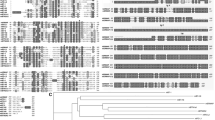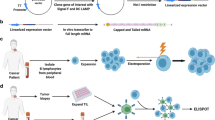Abstract
PEPTIDES bound to class I or class II major histocompatibility complex (MHC)-encoded molecules are ligands for the antigen-specific T-cell receptor of T-cells carrying the CD8 and CD4 antigens, respectively1. MHC class I-restricted T cells generally recognize peptides derived from processing of endogenously synthesized cellular antigens, whereas class II-restricted T cells usually recognize peptides derived from exogenous antigens entering antigen presenting cells. Accordingly, two separate pathways of antigen processing and presentation have been proposed2,3. The fungal metabolite brefeldin A (BFA)4, an inhibitor of protein transport from the endoplasmic reticulum5–7, inhibits presentation of endogenous antigens for MHC-restricted T-cell recognition8. The selectivity of BFA activity has been inferred to reflect presentation of a given antigen processed through the cytosolic or the endocytic route9,10. Here we show that BFA also greatly inhibits the presentation of exogenous protein antigens by MHC class II molecules to T cells, indicating a broader effect of this drug on antigen presentation and an additional similarity between the two processing pathways. As cycloheximide, a protein synthesis inhibitor, also inhibits presentation of protein antigens to class II-restricted T cells, the data indicate that peptides generated by processing of exogenous proteins bind to newly synthesized class II molecules for presentation to T cells.
Similar content being viewed by others
References
Möller, G. (ed.) Immun. Rev. 106, 1–187 (1988).
Morrison, L. A., Lukaker, A. E., Braciale, V. L., Fan, D. & Braciale, T. J. J. exp. Med. 163, 903–914 (1986).
Germain, R. N. Nature 332, 687–690 (1986).
Harri, E., Loeffler, W., Sigg, H. P., Stahelin, H. & Tamm, H. Helv. chim. Acta 46, 1235–1243 (1963).
Fujiwara, T., Oda, K., Yokota, S., Takatsuki, A. & Ikebara, Y. J. biol. Chem. 263, 18545–18552 (1988).
Lippincott-Schwartz, J., Yuan, L. C., Bonifacino, J. S. & Klausner, R. D. Cell 56, 801–813 1989).
Takatsuki, A. & Tamura, G. Agric. Biol. Chem. 49, 899–902 (1985).
Nuchtern, J. G., Bonifacino, J. S., Biddison, W. E. & Klausner, R. D. Nature 339, 223–226 (1989).
Yewdell, J. W. & Bennink J. R. Science 244, 1072–1075 (1989).
Nuchtern, J. G., Biddison, W. E. & Klausner, R. D. Nature 343, 74–76 (1990).
Adorini, L. et al. Proc. natn. Acad. Sci. U.S.A. 85, 5181–5185 (1988).
Shimonkevitz, R., Kappler, J., Marrack, P. & Grey, H. J. exp. Med. 158, 303–316 (1983).
Jensen, P. E. J. Immun. 141, 2545–2550 (1988).
Harding, C. V. & Unanue, E. R. J. Immun. 142, 12–19 (1989).
Shastri, N., Malissen, B. & Hood, L. Proc. natn. Acad. Sci. U.S.A. 82, 5885–5889 (1985).
Stockinger, B. et al. Cell 56, 683–689 (1989).
Unanue, E. R., Harding, C. V., Luescher, E. F. & Roof, R. W. Progress in Immunology VII (eds Melchers, F. et al.) 52–59 (Springer, Berlin, 1989).
Townsend, A. et al. Nature 340, 443–448 (1989).
Adorini, L., Appella, E., Doria, G., Cardinaux, F. & Nagy, Z. A. Nature 342, 800–803 (1989).
Cresswell, P. Nature 343, 593–594 (1990).
Adorini, L., Appella, E., Doria, G. & Nagy, Z. A. J. exp. Med. 168, 2091–2104 (1988).
Hedrick, S. M. et al. Cell 30, 141–152 (1982).
Ullrich, S. J., Robinson, E. A. & Appella, E. Molec. Immun. 23, 545–555 (1986).
Simonis, S., Miller, J. & Cullen, S. E. J. Immun. 143, 3619–3625 (1989).
Laemmli, U. K. Nature 227, 680–685 (1970).
Author information
Authors and Affiliations
Rights and permissions
About this article
Cite this article
Adorini, L., Ullrich, S., Appella, E. et al. Inhibition by brefeldin A of presentation of exogenous protein antigens to MHC class II-restricted T cells. Nature 346, 63–66 (1990). https://doi.org/10.1038/346063a0
Received:
Accepted:
Issue Date:
DOI: https://doi.org/10.1038/346063a0
- Springer Nature Limited
This article is cited by
-
Irreversible association of peptides with class II MHC molecules in living cells
Nature (1992)
-
Borna disease virus-infected astrocytes function in vitro as antigen-presenting and target cells for virus-specific CD 4-bearing lymphocytes
Archives of Virology (1992)
-
Segregation of MHC class II molecules from MHC class I molecules in the Golgi complex for transport to lysosomal compartments
Nature (1991)





